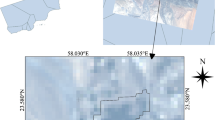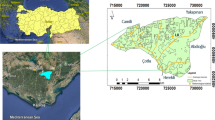Abstract
Estimating evapotranspiration is an essential step towards the calculation of crops irrigation needs. One of the most widely used methods for this estimation is Surface Energy Balance Algorithm (SEBAL), a method based on remote sensing imagery. In the current study, fusion images of Landsat 8 and MODIS satellites using Gram-Schmidt algorithm were employed to calculate actual evapotranspiration of the Amir Kabir sugarcane argo-industry company, Khuzestan, Iran. Furthermore, the amount of sugarcane evapotranspiration was estimated using Landsat 8 images and SEBAL algorithm, and finally, the results were compared with lysimeteric data. The comparison of evapotranspiration from Landsat 8 and lysimeteric data showed a correlation higher than 0.96, as well as a comparison of evapotranspiration from the Landsat-MODIS fusion images having a suitable correlation equal to 0.88 with the lysimeteric data. In this research, the amount of dry matter produced in farming year 2016–2017 was calculated by using the Monteith model and satellite images. The average dry matter produced (biomass) of sugarcane in this period estimated using Landsat 8 images was 52.51ton/ha and 42.45ton/ha with fusion images. The average water use efficiency from the dry matter ratio produced by the actual evapotranspiration estimated from satellite data for Landsat 8 images and Landsat-MODIS fusion images was 5.98 and 5.95 kg/m3, respectively. Also, the relationship between age and sugarcane varieties with yield and evapotranspiration rates calculated by the Monteith and SEBAL model indicated that the effect of the age of the sugarcane and varieties on its evapotranspiration rate is negligible. Finally, the relationship between the estimated evapotranspiration by Landsat 8 images and NDVI revealed that the extraction of NDVI values from images could be achieved with the proper accuracy of evapotranspiration.





Similar content being viewed by others
References
Ahmad, M. D., Biggs, T., Turral, H., & Scott, C. A. (2006). Application of SEBAL approach and MODIS time-series to map vegetation water use patterns in the data scarce Krishna river basin of India. Water Science and Technology, 53(10), 83–90.
Allen, R., Irmak, A., Trezza, R., Hendrickx, J. M., Bastiaanssen, W., & Kjaersgaard, J. (2011). Satellite-based ET estimation in agriculture using SEBAL and METRIC. Hydrological Processes, 25(26), 4011–4027.
Allen, R., Tasumi, M., Trezza, R., Bastiaanssen, W., Morse, T., Kramber, W., & Wright, J. (2005). Metric: High Resolution Satellite Quantification of Evapotranspiration. Kimberley-Id: Presentation Part Two-Energy Balance. In Workshop. University of Idaho.
Allen, R., Tasumi, M., Trezza, R., Waters, R. and Bastiaanssen, W., 2002. SEBAL (Surface Energy Balance Algorithms for Land). Advance Training and User’s Manual–Idaho Implementation. Version, 1:97.
Bastiaanssen, W. G., Menenti, M., Feddes, R. A., & Holtslag, A. A. M. (1998). A remote sensing surface energy balance algorithm for land (SEBAL). 1 Formulation. Journal of hydrology, 212, 198–212.
Bastiaanssen, W. G., Thiruvengadachari, S., Sakthivadivel, R., & Molden, D. J. (1999). Satellite remote sensing for estimating productivities of land and water. International Journal of Water Resources Development, 15(1–2), 181–194.
Craig, A., Bernard, L. and Brower, V., 2000. Process for enhancing the spatial resolution of multispectral imagery using pan-sharpening”, United States Patent, Appl. No: 09/069,232, 2000.
Elkatoury, A., Alazba, A. A., & Mossad, A. (2020). Estimating Evapotranspiration Using Coupled Remote Sensing and Three SEB Models in an Arid Region. Environmental Processes, 7(1), 109–133.
Frouin, R., & Pinker, R. T. (1995). Estimating photo synthetically active radiation (PAR) at the earth’s surface from satellite observations. Remote Sensing of Environment, 51(1), 98–107.
Ghaderi, A., Dasineh, M., Shokri, M., & Abraham, J. (2020). Estimation of Actual Evapotranspiration Using the Remote Sensing Method and SEBAL Algorithm: A Case Study in Ein Khosh Plain. Iran. Hydrology, 7(2), 36.
Ghamarnia, H., & Rezvani, S. V. (2014). Calculation and zoning of evapotranspiration using SEBAL method in the west of Iran (Main Darband Plain). Journal of water and soil, 28(1), 72–81.
Golabi, M., & Naseri, A. A. (2015). Assessment Aquacrop model to predict the sugarcane yield and soil salinity profiles under salinity stress. Iran Journal of Water and Soil Reseach, 46(4), 685–694.
Hamid, S. H., Mohamed, A. A., & Mohamed, Y. A. (2011). Towards a performance-oriented management for large-scale irrigation systems: case study, Rahad scheme. Sudan. Irrigation and drainage, 60(1), 20–34.
Hatfield, J. L., Asrar, G., & Kanemasu, E. T. (1984). Intercepted photosynthetically active radiation estimated by spectral reflectance. Remote Sensing of Environment, 14(1–3), 65–75.
Jaafar, H. H., & Ahmad, F. A. (2020). Time series trends of landsat-based ET using automated calibration in METRIC and SEBAL: The Bekaa Valley. Lebanon. Remote Sensing of Environment, 238, 111034.
Karimi, A. R., Farhadi Bansouleh, B., & Hesadi, H. (2012). Estimation of regional evapotranspiration using LANDSAT TM images and SEBAL Algorithm. Iranian Journal of Irrigation and Drainage, 4(6), 353–364.
Miryaghoubzadeh, M., Solaimani, K., Habibnejad Roshan, M., Shahedi, K., Abbaspour, K., & Akhavan, S. (2014). Estimation and assessment of actual evapotranspiration using remote sensing data (Case study: Tamar basin, Golestan province, Iran). Irrigation and water engineering journal, 4(15), 89–102.
Monteith, J.L. and Moss, C.J., 1977. Climate and the efficiency of crop production in Britain. Philosophical Transactions of the Royal Society of London B, Biological Sciences, 281(980): 277–294.
Moran, M. S., Maas, S. J., & Pinter, P. J., Jr. (1995). Combining remote sensing and modeling for estimating surface evaporation and biomass production. Remote Sensing Reviews, 12(3–4), 335–353.
Opoku-Duah, S., Donoghue, D. N. M., & Burt, T. P. (2008). Intercomparison of evapotranspiration over the Savannah Volta Basin in West Africa using remote sensing data. Sensors, 8(4), 2736–2761.
Paul, G., Gowda, P. H., Prasad, P. V., Howell, T. A., Staggenborg, S. A., & Neale, C. M. (2013). Lysimetric evaluation of SEBAL using high resolution airborne imagery from BEAREX08. Advances in water resources, 59, 157–168.
Ramos, J. G., Cratchley, C. R., Kay, J. A., Casterad, M. A., Martinez-Cob, A., & Dominguez, R. (2009). Evaluation of satellite evapotranspiration estimates using ground-meteorological data available for the Flumen District into the Ebro Valley of NE Spain. Agricultural water management, 96(4), 638–652.
Richards, R. A., & Townley-Smith, T. F. (1987). Variation in leaf area development and its effect on water use, yield and harvest index of droughted wheat. Australian Journal of Agricultural Research, 38(6), 983–992.
Safi, R., Mirlatifi, S. M., & Akbari, M. (2016). Assessment of water productivity of the Amirkabir sugarcane agro-Industry farms using Landsat 8 Satellite data. Iranian Journal of Irrigation and Drainage, 10(1), 36–47.
Semmens, K. A., Anderson, M. C., Kustas, W. P., Gao, F., Alfieri, J. G., McKee, L., et al. (2016). Monitoring daily evapotranspiration over two California vineyards using landsat 8 in a multi-sensor data fusion approach. Remote Sensing of Environment, 185, 155–170.
Serrano, L., Filella, I., & Penuelas, J. (2000). Remote sensing of biomass and yield of winter wheat under different nitrogen supplies. Crop science, 40(3), 723–731.
Soheylifar, Z., Mirlatifi, S.M., Naseri, A.A. and Assari, M., 2013. Estimating actual evapotranspiration of sugarcane by remote sensing. A case study: Mirza Kochak Khan sugarcane agro-industry company farms. Journal of water and soil science, 23(1), 151–163.
Steele, D. D., Thoreson, B. P., Hopkins, D. G., Clark, B. A., Tuscherer, S. R., & Gautam, R. (2015). Spatial mapping of evapotranspiration over Devils Lake basin with SEBAL: application to flood mitigation via irrigation of agricultural crops. Irrigation science, 33(1), 15–29.
Varlet-Grancher, C., Bonhomme, R., Charter, M., & Artis, P. (1982). Efficience de la conversion de l’energie solaire par un couvert vegetal. Acta Ecologia/Ecologia Plantarum, 3, 3–26.
Waters, R., Allen, R., Tasumi, M., Trezza, R., & Bastiaanssen, W. (2002). SEBAL. Advanced Training and User Manual: Surface Energy Balance Algorithms for Land.
Acknowledgement
we are grateful to the Research Council of Shahid Chamran University of Ahvaz for financial support (GN: SCU. WI98.281).
Author information
Authors and Affiliations
Corresponding author
Additional information
Publisher's Note
Springer Nature remains neutral with regard to jurisdictional claims in published maps and institutional affiliations.
About this article
Cite this article
Goshehgir, A.S., Golabi, M. & Naseri, A.A. Estimation and Comparison Actual Evapotranspiration of Sugarcane Using Separate and Fusion Satellite Images and Lysimeteric Data with Approach of Determining Water Use Efficiency. J Indian Soc Remote Sens 49, 1461–1474 (2021). https://doi.org/10.1007/s12524-021-01326-5
Received:
Accepted:
Published:
Issue Date:
DOI: https://doi.org/10.1007/s12524-021-01326-5




